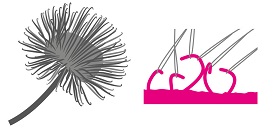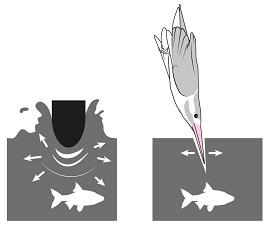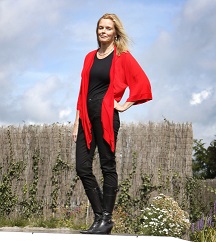In her book ‘Nature as an inventor’ (in Dutch), Ylva Poelman beautifully paints bionics as the subject of the future. Bionics is learning from nature: applying successful solutions from nature – billions of years of invention for free, as the subtitle runs. Bionics is sustainable physics and mechanics, just like fermentation is sustainable chemistry: using the efficiency, the energy and materials conservation and recycling in natural processes.

Ylva Poelman illustrates her theme of nature as an inventor with dozens of examples, one even more beautiful and fantastic than the other. Take climate control by termites in their nest (p.153). Termites live in synergy with moulds that need a constant temperature of about 30 degrees. Quite a challenge for little animals that live in a fdesert in which temperatures range from 40 degrees during the day to 1 degree at night. They solve that problem with an ingenious system of air circulation: at the bottom they construct inlets of fresh, cool air; at the top they have an outlet where they discard heated ‘used’ air. And the orientation of the construction to sunlight plays an important role. Pioneers of passive heating, these termites. Indeed: nature as an inventor. And whereas our traditional technology would solve these problems with pumps, air conditioning and heating, in short with energy use, passive heating enjoys an increasing popularity.
Nature as an inventor is efficient and sustainable
Ylva Poelman shows that imitation of nature will lead to smart, efficient and sustainable solutions for a vast array of activities, like gluing, drilling, constructing, clutching, jumping and moving. One of nature’s specialties is the construction that is both light and robust. As an example, the elephant’s skull is both very large and very light (p.85). If the head would be as heavy as the other parts of the body, the animal would not be able to keep it upright. Evolution solved this problem by constructing many cavities in the skull, enclosed by bone that is responsible for robustness. Nature applies the same principle in diatoms that also need to be light and strong (p.97-103). This design principle leads to many interesting forms that may inspire many engineering solutions. On the basis of this, engineers devised a procedure called ELiSE (Evolutionary Light Shell Engineering), and developed a database containing more than 90,000 single-cell organisms with an exoskeleton; the database lists the 3D structure of each organism, and information on the behaviour of the construction under standard conditions. Engineers use ELiSE structures in parts of many devices, like washing machines, ship hulls, motor car parts and the foundation of offshore wind turbines.

Learning from nature is a principle that can be applied in a vast array of subjects. The hibernation of golden hamsters suggests strategies for the treatment of Alzheimer’s disease (p.111). The desiccation and subsequent ‘coming to life again’ of the resurrection fern has been applied in better methods for the conservation of vaccines (p.112). Dolphins (p.70) and humpbacks (p.116) inspire the construction of energy-efficient blades and ventilators. Tubercles, copied from the humpback’s pectoral fins have been successfully applied in surfboard fins and the rotors of helicopters, ventilators and wind turbines. A technique to recover water from dew in the desert has been copied from the desert beetle (p.138).
Nature as an inventor also supplies us with design strategies
Nature not only supplies us with practical solutions but also with design strategies that we can use to solve constructive problems. Ylva Poelman sums up nature’s principles in a number of rules. Nature looks for efficiency, flexibility, adequate quality, care for the environment and smart structures. Together, these rules constitute a strategic breakthrough that can inspire solutions for constructive problems for many years to come, for instance in architecture. Even the behaviour of animals may be a rich source of inspiration: the strategies of ants and bees in discovering food, and of starlings in a swarm are determined by just a handful of rules, and are successful without an hierarchical structure – whereas there are a great number of rules in any human organisation, mostly of a strictly hierarchical nature, leading to many opportunities of derailment in the case of dysfunctional leaders. In short, ‘Nature as an inventor’ is a rich book that supplies us with practical examples and also inspires to explore, observe and develop. It should be translated into English right away.
And yet, the book is far from perfect. Firstly, each page shows that Ylva Poelman is a physicist with little affinity to chemistry. Therefore, she misses half of her subject. The author’s reflections on nature’s building bricks (proteins, carbohydrates, fats and nucleic acids) could have inspired her to many chapters on application of nature’s processes in chemical industry – indeed, fermentation – and materials development. And the passages on composite materials (and as a matter of fact each natural material is a composite) could have been much richer with a chemical input. Secondly, Ylva Poelman is much too modest. With the wealth of material that she collected, a typical American bragger like Jeremy Rifkin would have written a bestseller. Now I do not require Ylva Poelman to write a bestseller, but I suppose that she would like to be heard. And success starts with the suggestion that one is successful. Therefore, Ylva, celebrate the successes of bionics. In order to promote nature as an inventor itself.

Ylva Poelman, a physicist and astronomer, is a specialist in the field of bionics, innovation and people management. She is the initiator and motor of the Bionics Innovation and Expertise Centre in Groningen, The Netherlands. She writes a fortnightly column in the Dutch newspaper Trouw, entitled ‘The Bionic Woman’.
www.denatuuralsuitvinder.nl (in Dutch)
Ylva Poelman. De natuur als uitvinder, Miljarden jaren aan innovatie gratis beschikbaar. Amsterdam 2015. ISBN 978 90 488 2541 7. ISBN e-book 978 90 488 2542 4.
